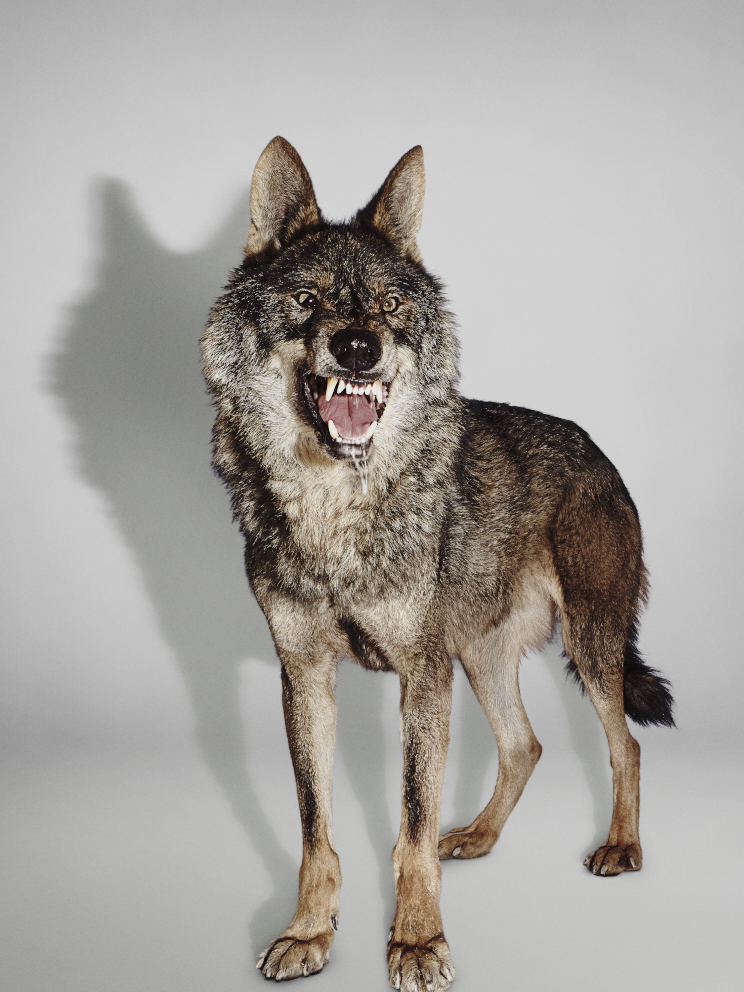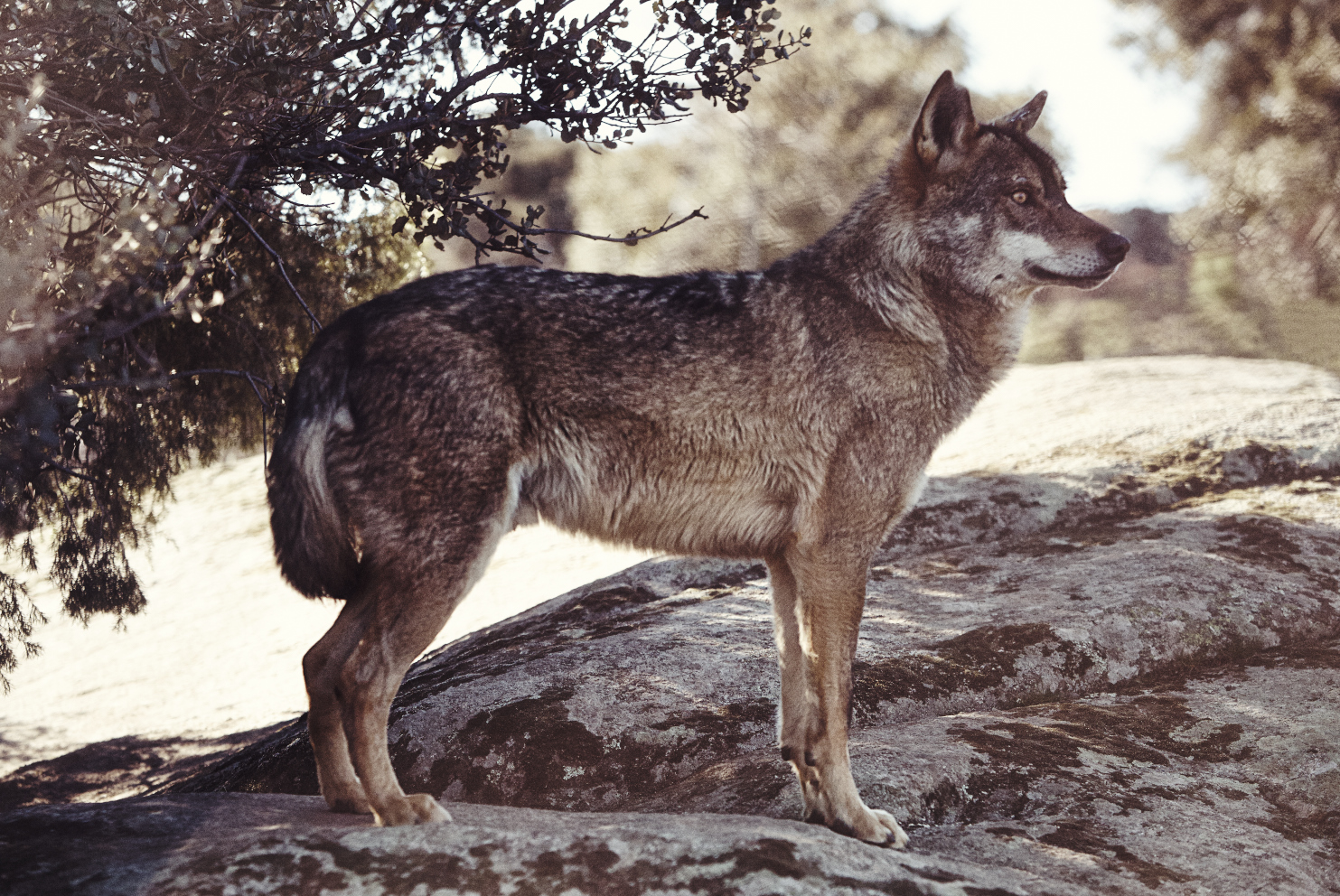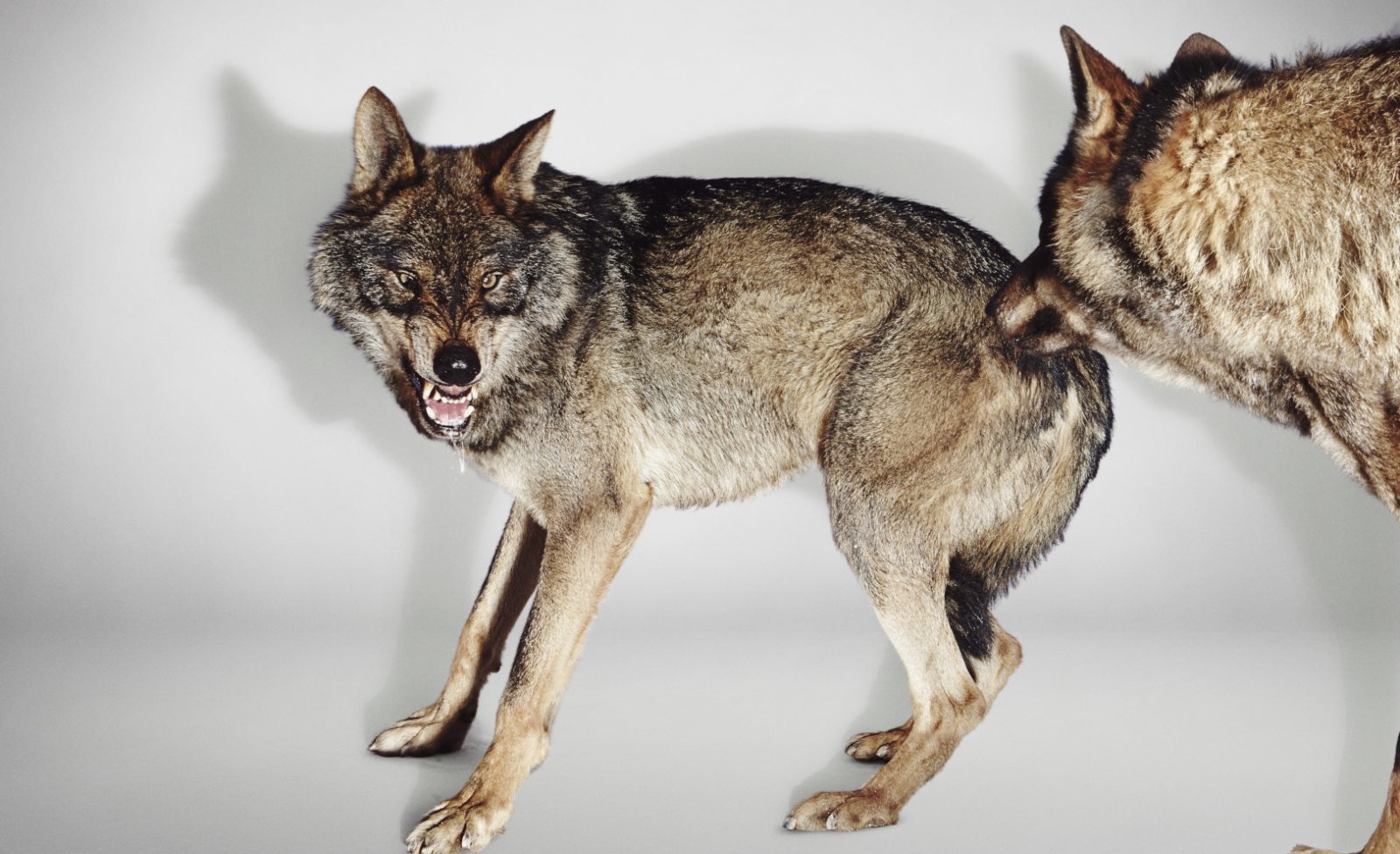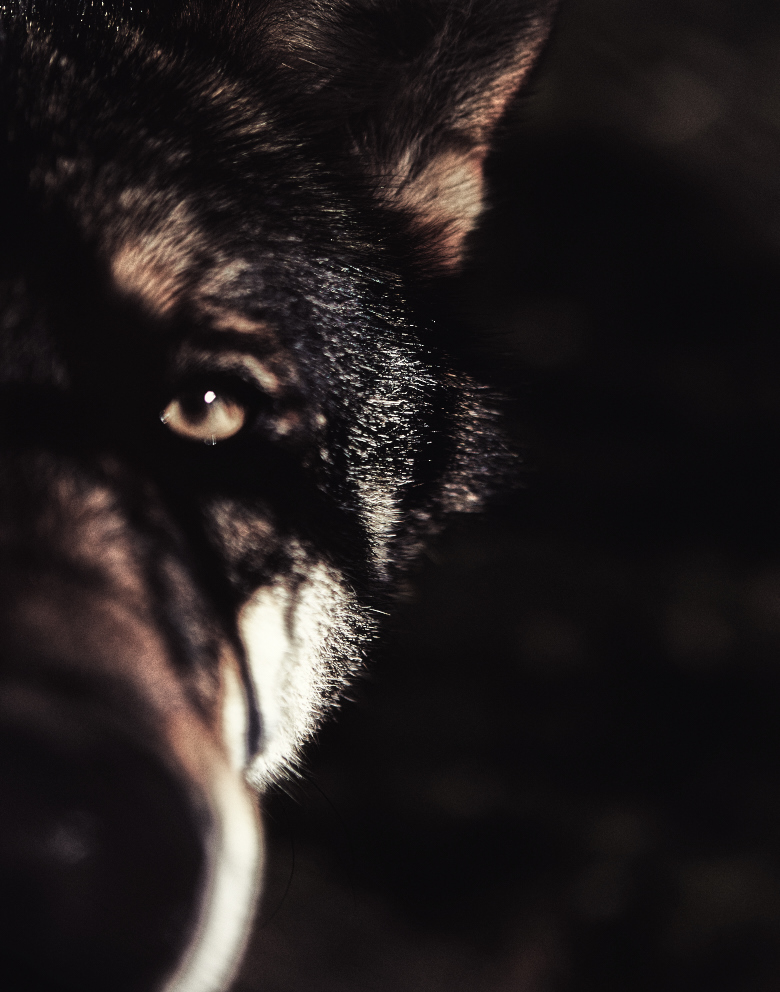It’s summer, and the ten goats that provide milk for the Maín cheese factory, located in Sotres in the high pastures of the Picos de Europa, graze freely in the meadows up in the mountains. The kids scamper among Leonese and Caucasian mastiffs, strong but lightweight dogs, ideal for guarding the animals that stray into the many cliffs and gorges that fragment the rock of the Picos. The idyllic charm of the scene will be broken the next day when Abel Fernández, the shepherd who looks after the herd, informs Jessica López, the owner of the cheese dairy, that a spring-born kid has disappeared, leaving a trail of dark fur behind. Jessica’s laconic gesture speaks for itself as she picks up her mobile phone to make the necessary arrangements: the dairy receives compensation of 102 euros for each goat that it loses to the wolf.
Little Red Riding Hood. The three little pigs. Peter and the wolf. Children are abducted for leaving home alone. Wolf-man, el lobisome. Beyond tales and legends, nowadays it is difficult to scare anyone by mentioning a species whose presence in our country has been confined to the northwest of the peninsula, especially to areas with scarce human presence such as the Picos de Europa. But it is no longer fear that the wolf provokes; rather, it is division, confrontation and a fierce debate as to how we should coexist with it. In the 21st century, the wolf is still very present in our collective psyche.
History of a country of wolves
Spain has the wolf in its DNA. The word wolf is present in more than 4,800 place names, many of us have it in our names, as it is the etymological root of surnames such as López or Ochoa, and in Basque it gives its name to the month of February, Otsaila, the month of the wolves. Apart from language, its presence is attested by the numerous wolf traps still in place in the north such as those of El Chorco de los lobos, or Caín de Valdeón (León): funnel-shaped fences made of stakes in which the wolves, ousted from the woods, were trapped and killed by hunters.
These traps took a backseat when gunpowder was popularized at the beginning of the 20th century, ushering in a period of the systematic annihilation of the wolf population in imitation of what had already taken place in most industrialised countries in Europe. This situation was further aggravated by the so-called “Alimañas Law ” of 1953, which defined the wolf as a “harmful animal” and thanks to which it is estimated that some 2,000 wolves perished in the first five years of its application. In the middle of the 20th century, the presence of the wolf in our country was reduced to 15 packs in the mountains of Zamora, Galicia and the Asturian-Leonese side of the Picos de Europa.
The twist in the script that allowed the Iberian wolf to avoid extinction came in the 1970s, when there were only 200 wolves left in the country. Félix Rodríguez de la Fuente and his series Man and the Earth portrayed it as a sophisticated social animal and not as a threat, thus managing to largely change the perception of the wolf in an increasingly urban and less rural society. This change in awareness, which was in line with what was happening internationally, was reflected in legislation with the inclusion of the species in the 1970 Hunting Law, which regulated hunting methods, the close season and penalties. Since the beginning of this century, the autonomous communities have been developing their respective Wolf Management Plans, which have allowed population control (i.e. hunting a number of individuals that does not endanger the survival of the pack) based on population censuses and notifications of attacks on livestock in each region.
These plans were essentially cancelled on 21 September by Order TED/980/2021 of the Ministry for Ecological Transition and Demographic Challenge. This includes in the list of Wild Species under Special Protection Regime (LESPRE) all the populations of Canis lupus, and not just those existing south of the Duero river as had been the case up to now. In this way, the wolf lost its status as a game species and hunting it is now prohibited in the whole of Spain.

A new story
The Ministerial Order stems from an administrative petition submitted by the Association for the Conservation and Study of the Iberian Wolf (ASCEL), which requested that all wolf populations be included in the “vulnerable” category of the Spanish Catalogue of Threatened Species (where they would enjoy proactive conservation policies) or, in case that was not allowed, in the LESPRE. The latter is what was finally recommended by the Scientific Committee for Flora and Fauna under the Ministry and what was approved by the State Commission for Natural Heritage and Biodiversity, in which the Directors General of the Autonomous Communities take part, in a close vote: nine votes in favour and eight against.
As soon as the result of the vote was known, the regional governments of Asturias (governed by the PSOE), Cantabria (Cantabrian Regionalist Party), Castilla y León (PP and Ciudadanos) and Galicia (PP), regions where 95% of the species lives, put aside their political differences and rejected the measure, citing the defence of the primary sector and threatening to go to court for what they understood to be an “invasion of exclusive competences that prevents conservation and population management.” The difference in positions is such that even within the same government, such as that of Aragon, President Javier Lambán (PSOE), disavowed the positive vote of the Directorate General for the Natural Environment of his Community, which is managed by Podemos. The Minister of Agriculture, Fisheries and Food himself, Luis Planas, declared that he did not agree with the measure: “I share the concern of the farmers and, as their minister, I am on their side.”
The four northwestern Communities argue that the wolf is recovering and no longer needs to be protected. According to the censuses carried out by the regions until 2018, the number of wolf packs has doubled compared to those recorded in the first decade of this century. For example, in Castilla y León, the region with the largest population, the 1,100 specimens registered in 1986 have grown to 1,600 in 2013. This increase is directly linked by farmers to a higher incidence of attacks on livestock: in Galicia, the number of warnings from farmers about attacks on livestock has risen from 691 (2010) to 1,303 (2020), an upward trend also found in other regions.
The number-crunching war
Mario Sáenz de Buruaga, scientific director of the wolf census in Castilla y León, Cantabria, La Rioja and the Basque Country, estimated in an interview with La Gaceta de Salamanca an increase of around 18% in the number of wolf packs in the last 15 years and said that the wolf is far from being in danger of extinction: “It can hardly be argued that hunting is now a threat to wolves when the increase is most evident in Castilla y León where it is a game species north of the Duero.”
But these figures from the northwestern Communities do not enjoy common backing from the scientific community. Ángel Manuel Sánchez, honorary professor in the Department of Life Sciences at the University of Alcalá de Henares and director of the National Volunteer Programme for the Iberian Wolf Census, which emerged in 2016 as an alternative to the official estimates, says that the data from the latest censuses are “overestimated.” “The data on the number of wolves per pack, which we estimate lies between three and five specimens, is based on our observations with photo-trapping cameras [and] are closer to those established by the ICONA (Institute for Nature Conservation) census back in 1988. That is why we cannot disagree more with the eight or ten specimens that are stated in Mario Saénz de Buruaga’s census.” A mismatch which, if true, would mean that the real number of specimens is half that which was estimated by the administrators.
Ignacio Martínez Fernández, president of ASCEL, the organisation behind the ministerial order, expresses himself in similar terms. In statements to SALVAJE, he criticizes the results and says that “censuses must be carried out on populations under rigorous criteria and time and money should be allotted for them; the only two censuses that have been carried out under these conditions in our country are 26 years apart in time, and both give the same number of groups. Is that an improvement? The wolf has not improved, wolves are still in the same bad shape as before because the Management Plans prevent their development.” Martínez also questions the regional scope of the censuses carried out by the Communities, since “it makes no sense to do a census on a part of the population, because they may be counting the same packs several times as they enter and leave their administrative boundaries. Even a national census is not perfect, as it would have to be done together with Portugal, to estimate all the populations in the Peninsula.”
Javier Talegón, a biologist who has participated in different wolf population diagnosis projects, says that “if we were to compare the demographic situation of our wolves between 1988 and the present day with a puzzle, we would have the same pieces, but they would be shifted around. It is true that in the last 20 years wolves have naturally colonised territories in Ávila and Madrid, but they have also disappeared from the Sierra de San Pedro and the Sierra Morena and have become rare, or have reduced in numbers in Burgos, Valladolid and Salamanca. We should not and cannot think of a global population increase.” Talegón also believes that “we must take into account an issue that is always forgotten when interpreting wolf trends in Iberia, namely their historical presence: wolves occupied the whole peninsula at the end of the 19th century. Nowadays, they are distributed over an area of only about 150,000 square kilometres.
Ignacio Martinez of ASCEL has also commented on the extent of the wolf’s presence. “Italian wolves are arriving in the Pyrenees, but no wolves are arriving from north-western Spain. The fact that the population is so small means that it cannot expand, and this does not correspond to what is being declared by the Communities.” Therefore, for ASCEL, the Ministerial Order does not go far enough and they will continue working for the Canis lupus to be included in the Spanish Catalogue of Threatened Species so that its conservation will be the object of proactive measures. “The wolf is our top predator, there is never going to be overpopulation. In a group, only one pair reproduces, and the rest are inhibited. Right now, its viability is in question because of genetic diversity problems, and that’s why we need it to expand.”

Fences in the field
Marta García, the owner of the Val de Mazo livestock farm and member of Ciudadanos in the Parliament of Cantabria, is clear about her vocation: “It is a job that is as hard as it is satisfying,” she says “Every time our animals are attacked it is an attack on our freedom to be able to work freely and with dignity.” Both García in Soba and Abel Fernández and Jessica López in Sotres end their days without knowing what they will find on the hills the next day. Their cattle spend the night protected by mastiffs and, in Abel’s case, by his own walking stick.
Marta and Abel believe that the mastiffs, although effective, are not enough: “I would need 10 dogs to effectively protect a single herd. And it costs me the same to feed 10 mastiffs as it does to assume that, over the course of the year, I’m going to lose five goats to wolf attacks,” Abel Fernández admits taciturnly. To which Jessica adds that “then the mountain would be full of dogs, and tourists wouldn’t be able to ramble so peacefully.” Marta García sums up their position: “We don’t want to see the extinction of the Iberian wolf. We want to guarantee the conservation of the species through the Management Plans: wolves yes, but their population needs controlling.”
The major agricultural groups hold a similar position and link their ability to kill wolves with the survival of livestock and the rural environment itself. According to Joaquín Antonio Pino, the president of ASAJA (Agrarian Association of Young Farmers) in Ávila, “the ministry lives on a different planet. If you want to fight against depopulation you have to defend the livestock farmer because if not, you are driving out the few people who are still left in the villages,” he told El País.
In spite of all this, the position of livestock farmers is not monolithic. There are several farmers and projects that support the adaptation of man to wolf, and not the other way round, with the adoption of preventive measures such as the use of mastiffs, enclosures and electric fences or shepherds and changes in management. According to the Life COEX project that was carried out between 2004 and 2008 in which 75 mastiffs, 30 electric fences and 15 fixed enclosures were donated to an area recently recolonised by wolves in the provinces of Salamanca, Avila and Segovia, the use of these methods showed reductions in the number of dead or injured heads of cattle: 61% in the case of mastiffs, 99.9% for electric fences and 100% for fixed enclosures. A decade later, 92% of farmers were satisfied or very satisfied with the methods used.
Javier Arroyo, a 33-year-old farmer who manages 50 adult cows, 20 calves and 650 sheep with the help of five mastiffs in Cortos, in the province of Ávila, acknowledges that the wolf “is of course a problem for livestock,” but he is also clear that “it is part of the environment. It has come to stay and we have to live with it.” Javier uses GPS trackers, ensures groups calve at the same time so that the mothers defend their young together, and has installed electric shepherds in his pastures. “Against the wolf, the electric shepherd is not very effective because it can slip through the wires, but in this way, I prevent the cows from dispersing, which would be more dangerous, and I can also manage the pastures,” he explains in an interview with El País. This agricultural engineer believes that the depopulation of rural areas cannot be blamed on wolf attacks because it is a phenomenon that “happens everywhere, whether there is a wolf there or not,” and argues that it is a species that “controls ecosystems”, because by hunting wild boar, goats and sick deer, it stops the spread of brucellosis, scabies and tuberculosis, which are transmitted to livestock. “And hunting doesn’t do that”.
For Ignacio Martínez of ASCEL, “the basic question is that if someone looks after the livestock there is no damage,” and he believes that “it is the Spanish Government’s obligation to protect the wolf. If this means losing votes, things will have to be explained better.” According to Martínez, it is a question of prioritising “the public over the private. The protection of biodiversity is a constitutional priority, as reflected in article 45, which is not the case with livestock farming. CAP subsidies are conditional on the conservation of biodiversity, so whoever wants to collect them cannot be found undermining these key EU directives.”

The courage of a wolf
WWF’s director of conservation, Luis Suárez, described the inclusion of the wolf in the LESPRE as a “historic event” and hopes that with it “all the benefits that this species brings to ecosystems and society will be properly valued in order to prioritise its conservation and support measures for coexistence.” These ecosystem services to which Suárez refers are included in the document “What the wolf gives us” published by WWF. As a predator at the top of the food chain, the wolf is a regulator of ecosystems, and when it disappears, imbalances occur and the populations of its prey spiral out of control. Among the wolf services cited in the paper are the elimination of other species that cause death and injury to humans and livestock such as feral dogs, CO2 monitoring, limiting the number of herbivores and allowing forest recovery, increasing the diversity of scavengers that take advantage of the remains of their prey, and even some direct benefits to farmers, such as increasing agricultural production by controlling herbivore species that damage crops or the aforementioned prevention of the spread of livestock diseases.
WWF also defends the direct economic potential of the wolf, for example for rural tourism. For Javier Talegón, who runs the Llobu [wolf – trans.] Ecotourism and Environmental Education Centre in the Sierra de la Culebra, the numbers are clear. “According to a study by the Spanish Government carried out in 2016, tourism associated with the direct observation of this species in the Sierra de la Culebra generated 1.8 million euros in the area and mobilised some 3,100 people each year. Throughout the same territory and until the hunting ban on this species, the annual hunting of about 10 wolves attracted about 10 hunters to the area, who spent less than four days in the area and generated, overall, less than 50,000 euros per year. The disproportion was enormous.”
The very coexistence of livestock and canines can be a marketing asset. Rosa González and Alberto Fernández manage the sheep farm Pastando con lobos, in Sanabria, Zamora, in a wolf-producing region par excellence. “We are aware that the wolf has to be there. Obviously, it would be easier and cheaper for us if there were no wolves, but that is not negotiable, so we decided to look at it from a positive angle and make the most of it.” So they decided to make a virtue out of necessity, which led them to certify that their lambs have been raised in a wolf-friendly environment thanks to the preventive measures they have adopted, such as guarding their 1,000 ewes every night or always being with the livestock when they graze. Grazing with wolves has the backing of organisations such as the WWF and GREFA, and they believe that “with the help of the Administration to tackle prevention measures, the wolf can definitely be an asset for our businesses.”
But these pioneering initiatives alone might not be enough to change the perception that the wolf has a negative economic impact on society and is but another nail in the coffin of the livestock sector. The adoption of preventive measures is a costly investment, and 55% of the users of the above-mentioned Life COEX project require public aid in order to adopt them. In terms of compensation, the Junta de Castilla y León paid 4.6 million euros for damage to livestock farmers in the period 2015 to 2019, and the Xunta de Galicia paid 1.7 million euros between 2016 and 2019. To these costs must be added the profits lost from hunting permits that will no longer be paid. According to the head of the Spanish Hunting Federation in Zamora, José Antonio Prada, “hunting each wolf specimen costs around 6,000 euros,” which, multiplied by several specimens, represents a very significant amount for the small municipalities of these depopulated areas.

Seeking consensus
“I believe that there are very few farmers who are against the existence of the wolf, but in this conflict the most extreme positions and arguments, put forward by those that do not recognise or respect the other side, are the most dominant in the networks and the media, and make the differences increasingly greater,” says Julio Majadas, from the Entretantos Foundation, responsible for the Grupo Campo Grande project, an initiative that emerged in 2016 that seeks to address the socio-environmental conflict. Media clamour, electioneering interests and the polemical nature of social networks, among other factors, mean that the different positions on the wolf are increasingly fierce and confrontational, making it difficult to find solutions. After an initial analysis of the social perception of the conflict, which confirmed that the control of wolf populations was one of the debates that generated the greatest degree of dissension, they decided to set up the Group and approach the issue from a social mediation perspective.
Through interviews with actors representing different sectors, such as cattle ranchers, conservationists, scientists and academics, the Group worked through the different viewpoints and topics used in the debate and defined the arguments and red lines blocking the agreements. “Through social mediation techniques, we investigated whether it was possible to bring their positions closer together, and from this effort emerged the Campo Grande Group Declaration,” a document that collates agreements as to the situation and the causes of the conflict, suggesting some proposals for reducing it. “The Group has been a clear example of people who arrived with preconceived ideas about the arguments of the other side, and through dialogue, they have come to understand, empathise with and respect other positions.” For Majadas, if agreements are to be reached, there must be room for compromise on the part of all sectors.
“One of the conclusions reached in the Group is that preventive measures are necessary, but also that they are not always effective or, for that matter, feasible. For example, in Asturias, if we are in an extensive system where a cow grazes in woodland and in the mountains, how can you do prevention with mastiffs? If you are in a system where the cattle cannot graze during the day because of the summer heat, does it make sense to confine the cattle at night?” The biologist believes that one has to look for alternatives to foster coexistence and to innovate both technologically and socially, but above all to focus on ensuring that the coexistence of livestock and wolves does not burden the livestock-farmer, and does not involve extra effort or cost him more. “If extensive livestock-farming provides environmental services, and we want to enhance coexistence, we must focus on other approaches, as it seems that right now not all prevention solutions always work.”
Another of the conclusions of the Campo Grande Group’s enterprising team is the need for greater transparency and participation on the part of the administration. “The lack of accessible information and of more transparent, participatory processes aggravates the conflict. If a Management Plan is drawn up, you need to open it up to the participation of the people affected and to improve certain aspects of governance, as well as involve the users of the environment, be they stockbreeders, conservationists or rural associations, in the planning process.”
While initiatives such as the Campo Grande Group seek understanding between opposing sides in a debate that the ministerial order has further inflamed, it seems that the conflict is no longer limited to the coexistence between humans and canines, but has spread to the heart of the human species itself. And perhaps this should not come as a surprise. After all, like the Romans, inhabitants of a city whose founder was suckled by a she-wolf, once said: homo homini lupus est. Man is wolf to man.







